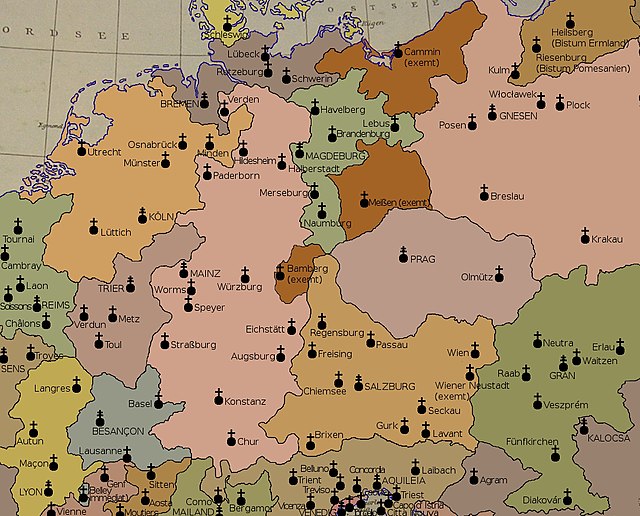Roman Catholic Diocese of Trier
Latin Catholic territory in Germany From Wikipedia, the free encyclopedia
Latin Catholic territory in Germany From Wikipedia, the free encyclopedia
The Diocese of Trier (Latin: Dioecesis Trevirensis), in English historically also known as Treves ([tɾivz]) from French Trèves, is a Latin Church ecclesiastical territory or diocese of the Catholic church in Germany.[1][2] When it was the archbishopric and Electorate of Trier, it was one of the most important states of the Holy Roman Empire, both as an ecclesiastical principality and as a diocese of the church. Unlike the other Rhenish dioceses—including Mainz and Cologne–Trier was the former Roman provincial capital of Augusta Treverorum. Given its status, Trier has continuously been an episcopal see since Roman times and is one of the oldest dioceses in all of Germany. The diocese was elevated to an archdiocese in the time of Charlemagne and was the metropolitan for the dioceses of Metz, Toul, and Verdun. After the victory of Napoleon Bonaparte of France, the archdiocese was lowered to a diocese and is now a suffragan in the ecclesiastical province of the Archdiocese of Cologne. The diocesan cathedral is the Cathedral of Saint Peter. The Cathedral Chapter retains the right to elect the bishop, rather than selection by papal appointment.[3]
Diocese of Trier or Treves Dioecesis Trevirensis Bistum Trier | |
|---|---|
 Trier Cathedral | |
 Coat of arms | |
| Location | |
| Country | Germany |
| Ecclesiastical province | Cologne |
| Statistics | |
| Area | 12,870 km2 (4,970 sq mi) |
| Population - Total - Catholics | (as of 2010) 2,468,000 1,504,500 (61%) |
| Information | |
| Denomination | Catholic Church |
| Sui iuris church | Latin Church |
| Rite | Roman Rite |
| Established | 1st Century |
| Cathedral | Cathedral of Trier |
| Patron saint | Mary, Mother of God Saint Matthias |
| Current leadership | |
| Pope | Francis |
| Bishop | Stephan Ackermann Bishop of Trier |
| Metropolitan Archbishop | Rainer Maria Woelki |
| Auxiliary Bishops | Robert Brahm, Jörg Michael Peters |
| Map | |
 | |
| Website | |
| bistum-trier.de | |


The bishops of Trier were already virtually independent territorial magnates in Merovingian times. In 772 Charlemagne granted Bishop Wiomad complete immunity from the jurisdiction of the ruling count for all the churches and monasteries, as well as villages and castles that belonged to the Church of St. Peter at Trier. In his will he also elevated the diocese to the Archdiocese of Trier, with suffragans on both sides of the Rhine. This arrangement lasted over a thousand years.
In Early Modern times, the archdiocese of Trier still encompassed territory along the Moselle River between Trier, near the French border, and Koblenz on the Rhine. The Archbishop of Trier, as holder of an imperial office was traditionally an Imperial Elector of the German king. The purely honorary office of Archchancellor of Gaul arose in the 13th century. In this context that was taken to mean the Kingdom of Burgundy-Arles, technically from 1242 and permanently from 1263, and nominally until 1803. Arles along with Germany and Italy was one of the three component kingdoms of the Empire.
The last elector removed to Koblenz in 1786. From 1795, the territories of the Archbishopric on the left bank of the Rhine — which is to say almost all of them — were under French occupation, and were annexed in 1801 and a separate bishopric established (later assuming control of the whole diocese in 1803). In 1803, what was left of the Archbishopric was secularized and annexed by the Princes of Nassau.
Seamless Wikipedia browsing. On steroids.
Every time you click a link to Wikipedia, Wiktionary or Wikiquote in your browser's search results, it will show the modern Wikiwand interface.
Wikiwand extension is a five stars, simple, with minimum permission required to keep your browsing private, safe and transparent.